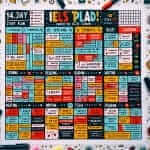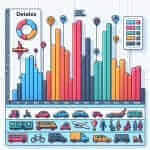The IELTS Reading section is one of the four skills tested in the IELTS exam, vital for assessing your ability to understand and process written English. This section consists of three passages with a total of 40 questions, to be completed in 60 minutes. Understanding the common types of questions and what each entails can markedly improve your performance. This article discusses the common IELTS Reading section types, providing examples, practical tips, and common pitfalls to avoid.
Understanding the IELTS Reading Section Types
1. Multiple Choice
Explanation
In Multiple Choice questions, you’ll be given a question or sentence stem, followed by three or four options. You need to select the correct answer(s) based on the passage.
Example
From the passage on climate change:
“What is the main cause of recent climate change, according to the passage?”
A) Natural variability
B) Industrial activities
C) Volcanic eruptions
D) Solar radiation
Practical Application
- Skim the passage to get the gist before diving into specific questions.
- Identify keywords in each question to locate the relevant section in the passage.
- Eliminate clearly wrong answers first to improve your odds of choosing the correct one.
2. True/False/Not Given
Explanation
You’ll be asked to determine whether statements are True, False, or Not Given based on the passage.
Example
From a passage on the history of aviation:
“Amelia Earhart was the first woman to fly solo across the Atlantic Ocean.”
- True
- False
- Not Given
Practical Application
- True: The statement agrees with the information.
- False: The statement contradicts the information.
- Not Given: The information is not found in the passage.
3. Matching Headings
Explanation
Here, you’re asked to match headings to paragraphs or sections in the passage. Each heading summarizes the main idea of a paragraph.
Example
Match the following headings to the paragraphs in a passage about the rainforest:
- Biodiversity and Ecosystems
- Threats to Rainforest
- Conservation Efforts
Practical Application
- Read all headings first to understand the different ideas.
- Skim each paragraph to determine the main idea quickly.
- Match accordingly, confirming that no two paragraphs should share the same heading.
4. Sentence Completion
Explanation
You need to complete sentences using words from the passage. The number of words will usually be limited.
Example
From a passage on renewable energy:
“Wind turbines generate electricity by using the power of __.”
Practical Application
- Understand the context of the sentence.
- Locate the relevant information in the passage.
- Use the exact words from the passage, adhering to word limits.
5. Summary Completion
Explanation
You’ll be given a summary of information from the text, with some gaps. You need to fill these gaps using words or phrases from the passage or a word list.
Example
Complete the summary using words from the list:
The Great Wall of China was primarily built as a __ to protect against invasions and __ raids.
Words: defense, weather, trading, cultural
Practical Application
- Read the summary first to understand what it talks about.
- Find the section in the text that matches the summary.
- Insert words so that the summary is coherent and meaningful.
6. Matching Features
Explanation
You must match a set of features (e.g., names, dates, events) to the correct part of the passage.
Example
Match the scientists to their inventions.
- Alexander Graham Bell
- Thomas Edison
- Nikola Tesla
Practical Application
- Identify the features in the passage.
- Understand the context of each feature.
- Match correctly by linking the feature to the passage information.
7. Matching Information
Explanation
You must locate specific information within various sections or paragraphs.
Example
Locate where the following information appears in the passage:
“Extraction methods for natural gas.”
- Paragraph A
- Paragraph B
- Paragraph C
Practical Application
- Scan the passage for keywords mentioned in the question.
- Read the relevant section to ensure it matches the required information.
- Select the correct paragraph.
 IELTS Reading Section Tips
IELTS Reading Section Tips
Common Pitfalls and How to Avoid Them
- Skimming vs. Scanning Misunderstandings: Skim for the gist first, then scan for specific information.
- Time Management Issues: Practice under timed conditions.
- Over-interpretation in True/False/Not Given: Stick strictly to the text information.
- Incorrect Word Limits in Sentence Completion: Pay heed to the word limit strictly.
Effective Practice Techniques
- Regular Reading Practice: Diverse genres and topics.
- Timed Mock Tests: Mimic exam conditions.
- Review Mistakes Thoroughly: Understand why an answer was wrong.
- Use Reputable Resources: Books like Cambridge IELTS series.
Conclusion
Understanding the common IELTS Reading section types can significantly enhance your test performance. Focus on practicing each type with real IELTS materials and avoid common pitfalls through effective strategies. Keep practicing, stay confident, and aim for excellence in your IELTS journey. If you have any questions or need further guidance, feel free to leave a comment or explore more content on our site for comprehensive IELTS preparation resources.


